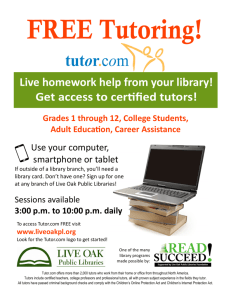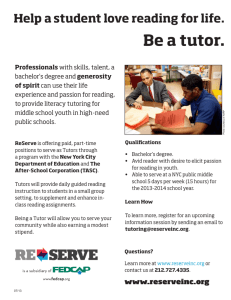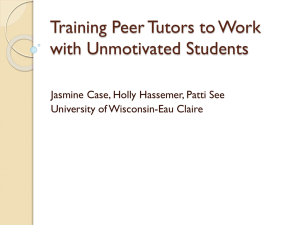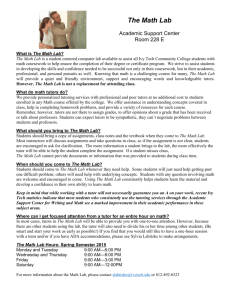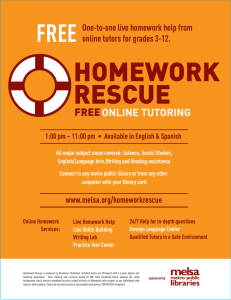Using an online learning community within Essential Skills tutor
advertisement
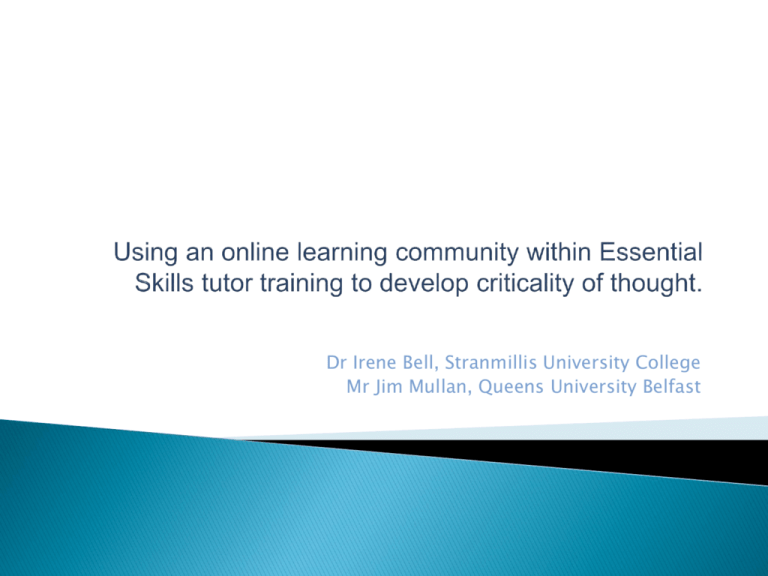
Dr Irene Bell, Stranmillis University College Mr Jim Mullan, Queens University Belfast Stranmillis UC students: 25 BEd (ITE) students undertaking a degree plus status course in Essential Skills in Numeracy. QUB students: 20 students from a workplace background (not ITE) undertaking a part-time 2 year diploma in teaching essential skills. 1 student (volunteer) from each group taught a lesson in a Further Education College. This lesson was videoed. Using cloud technology 2 separate learning communities were established. (Digital interactive video exploration and reflection) • The Stranmillis UC area held the video from QUB and was open to Stranmillis students and both tutors. • The QUB area held the video from Stranmillis and was open to QUB students and both tutors. • Students engaged in reflection on the video on two occasions (at least) and constructively analysed the video of the teaching of the student from the other institution. Printouts from the online discussion. • Students critiqued their thoughts on participating in a cross institution exercise. Their analysis was entitled: Using video to explore classroom practice in teaching numeracy from different perspectives and to develop communities for sharing perspectives on video records • Submission of reflective essays on using the on-line environment. In each case the exercise was incorporated into the assessment of the course on a pass/fail basis. • Evaluate the ability of each individual group to engage in on-line discussion • Evaluate the ability of each group to analyse and critically reflect on what they were viewing • Compare the similarities and differences made by the students from the two institutions • Analyse the students’ written reflections on using an on-line community The two students who had volunteered for their teaching to be videoed were invited to engage in the discussion forum. The Stranmillis student decided not to engage at any level with the discussion. The QUB student decided to read the comments on her teaching but not to make any response. The enthusiasm with which the students engaged in the process as evidenced by the substantial quality comments they made. The tutors offered scaffolding for the discussion but with hindsight this wasn’t necessary. Difference in confidence between the two groups of students in engaging in the process. “I found it reassuring that another tutor agreed with my comment” Liked repeated viewings of the teaching. ‘I believe that these offered the optimum environment in which to view and comment on the video without bias or subjectivity’. • • • • • • • • • • • Share the intended learning with the students at the start of the lesson Recap and link the work to previous learning or set the work in an appropriate realworld context; Provide clear exposition involving, where appropriate, multiple explanations, use a variety of activities, including ICT and practical equipment, which entails the pupils working individually, in pairs or in groups; Provide opportunities for the students to problem-solve; Integrate, when appropriate, the use of effective mental mathematics strategies; Use skilful questioning, challenging the students’ understanding and requiring them to draw conclusions and justify their thinking; Highlight common misconceptions and exploit these in a sensitive way; Relate the on going work to other parts of the course to encourage the students make interconnections and think of mathematics holistically; Engage the students fully by ensuring that the lesson had appropriate pace, challenge and progression; Teach step-by-step algorithms only when necessary; Encourage the students to think and talk about how they learn and what they have learnt, often through appropriate plenary sessions at the end of lessons. Students initially commented on Classroom layout Initial relationship with the class Poor inclusion awareness on the tutors part (mini white boards) Formative assessment as the lesson progressed Tutors physical appearance portraying ‘uncomfortable scenario’ (positively presented) Handling the entrance of late learners Positive comments included: Very good use of resources Very good subject knowledge as evidenced by several strategies questioning at high level within lesson use of inverse operations not afraid to take explanations and ask ‘how’ or ‘why’. At the second stage of the process reflecting on their peer’s comments required professional development to deliver constructive criticism. Comments focusing on teaching and learning Used phrases like – a more effective strategy in this situation – enhance visual learning – structured teacher led discussion – success criteria should be task specific Lack of recording worked examples Use of everyday resources compared to commercial resources Tutor needs to further develop incorrect answers or ask a respondent for an explanation of their answer More use of alternative solutions Tutor did request formative feedback Very practical use of resources Very comfortable relationship with the students – teacher approach appropriate to the age group being taught Good use of active learning Related to assessment Learning Intentions used accurately Observing another student made them question their own practice – increased self-awareness Easier to analyse another person teaching rather than you own – comments were all evidence based – the conversation was easier. Peer comments made me think about missed observations – DIVES supplied the evidence for their comments. Video allowed me to revisit the lesson. Peer feedback was used as a means of promoting higher level thinking (student comment). “the most fundamental metacriterion for judging whether or not good teaching is happening is the extent to which teachers deliberately and systematically try to get inside students’ heads and see classrooms and learning from their point of view.” (Brookfield, 1995. p.35) ”Exchanged places with the learners” Viewed lesson as the learner, teacher and the ‘college tutor’. Brookfield, S. (1995) Becoming a Critically Reflective Teacher. San Francisco: Jossey Bass Further Education Sector All new Essential Skills lecturers in the further education sector will be required to have a degree in their subject specialism, and to undertake the Certificate in Teaching - year 1 of the Post Graduate Certificate in Education (Further Education) (PGCE(FE)) - within their first year of teaching. They will be required to complete the PGCE (FE) within three years of appointment. Government-Funded Education, Training and Employment Programmes All new Essential Skills tutors, delivering government-funded training and employment programmes, will be required to have a degree in their subject specialism, and to achieve the Certificate in Teaching - year 1 of the PGCE (FE) within their first year of teaching. Progression to the second year of the PGCE (FE) will be optional.
